
Original Link: https://www.anandtech.com/show/2146
Corsair Dominator DDR2-1111: Dual-Path Cooling Pushes Performance
by Wesley Fink on January 1, 2007 5:15 AM EST- Posted in
- Memory
It is really good to see the kind of innovation that is going on in the memory market right now. In recent reviews there were many comments about "cookie-cutter" sameness in DDR2 memory products. Then OCZ introduced their innovative Flex XLC memory with the option of water cooling that we covered in OCZ Flex XLC: PC2-9200 Pushes the Envelope. That memory shook up notions of what represented an enthusiast memory product.
Even before Flex XLC was introduced Corsair was shaking up the high-end memory market with their new Corsair Dominator memory. We had first used Dominator modules in our review of the NVIDIA 680i motherboard. The Dominator memory was a big contributor to the record-setting memory performance we achieved on that board. That experience meant we needed to follow up the Flex XLC review with a review of another memory to break out of the ordinary - Corsair Dominator.
Our samples tested with the 680i were DDR2-1142, which actually topped by a few MHz the incredible DDR2-1300 we achieved with the OCZ. The Corsair Dominator 1142 pioneered a unique taller PCB board with integrated fin cooling and an optional top cooling fan.

The look and functionality of the DDR2-1142 Dominator memory, fully decked out, certainly gets your attention. However, when we approached Corsair about reviewing the 1142 Dominator they suggested we look at their latest super high speed product, which is Corsair Dominator DDR2-1111 (PC2-8888). We were told that while the 1111 is rated a bit slower the performance rating is at CAS 4 instead of CAS 5 like the 1142. That meant the 1111 was actually a faster memory with the promise of lower latency.
Corsair remains one of the most innovative companies in the memory market. If there is a something new in the memory market, you can count on the fact that either Corsair introduced it or they have a very similar product. It is no surprise then to see such an innovative new memory product from Corsair. The dual-path cooling and extremely high speed ratings are pretty exciting. The question, of course, is how the Corsair Dominator DDR2-1111 4-4-4 actually performs in our tests systems. Is it the equal of the other top RAM in the market, or does it set new performance standards for DDR2 memory? We will find answers to those questions in our Memory Test beds.
Corsair Dominator Series
Corsair has a long and illustrious history as an innovator in the memory market. For many years the only recognizable brand of enthusiast memory was Corsair. That has changed in recent years, but that is the reason many computer enthusiasts are so loyal to the Corsair brand.
Corsair is the most widely recognized brand of enthusiast memory in the world. It is also widely distributed, making the Corsair brand easy to find just about anywhere you might be located. Corsair has been manufacturing high-speed memory since 1994, and as a result the company has supplier relationships with many computer manufacturers. Corsair maintains an extensive line of memory, ranging from their Value Select brand of low-cost memory to their top-end XMS line.
XMS2 Dominator is Corsair's name for a new memory series. It describes some unique innovations in the PCB and memory cooling.
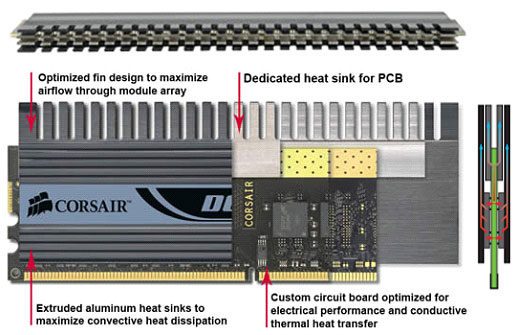
As you can see from the diagram Dominator uses two paths for memory cooling:
- Conventional heat release through the front of the memory chips into a pair of super efficient heat sinks
- Additional dissipation through the back of the memory chips and through the circuit board through heat fins integral to the PCB.
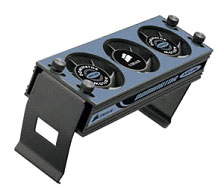
The Dominator Airflow fan uses three 40mm tachometer controlled fans. The fans run at moderate speed to provide adequate airflow but still remain near silent when operating. The Dominator Airflow fan kit comes standard with the Dominator PC2-8888 2GB memory kit, but it is also an optional accessory that will work with any DDR-2 or DDR memory modules to provide additional cooling.
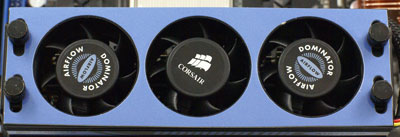
The Corsair fan design is very clever and is a much more secure solution for fan cooling than a precarious large fan laid over the top of memory modules. If you seriously overclock your memory then you should definitely consider adding this 3-fan option to your system, no matter what memory you use.
Corsair has made Dominator cooling widely available in their high-end XMS line. You can find a Dominator version of almost any Corsair Super Performance memory.
| Cosair XMS2 Dominator Modules | ||||||||
| Part Number | Rated Speed | Size | Timings | Kit | Fan Included | |||
| TWIN2X2048-9136C5D | XMS2-9136 | 2048MB | 5-5-5-15 | 2X240DIMM | No | |||
| TWIN2X2048-8888C4DF | XMS2-8888 | 2048MB | 4-4-4-12 | 2X240DIMM | Yes | |||
| TWIN2X2048-8500C5D | XMS2-8500 | 2048MB | 5-5-5-15 | 2X240DIMM | No | |||
| TWIN2X2048-6400C3DF | XMS2-6400 | 2048MB | 3-4-3-9 | 2X240DIMM | Yes | |||
| TWIN2X2048-6400C4D | XMS2-6400 | 2048MB | 4-4-4-12 | 2X240DIMM | No | |||
NVIDIA and Corsair have jointly developed an open standard for memory profiles in the SPD (Serial Presence Detect) called EPP. It was first unveiled at the launch of the NVIDIA 500 family of chipsets and has been expanded since. The SPD profiles are called EPP (Enhanced Performance Profiles) and they are a standard feature of all Dominator memory modules. This allows easier setting of aggressive overclocking timings if the motherboard supports EPP profiles.
Dominator PC2-8888C4DF Specifications
Corsair supplies Dominator DDR2-1111 in the largest memory package you will likely see. The memory ships in a box about the size of a package for a video card. The box contains a matched pair of 1GB Dominator DIMMs and a Dominator Airflow fan unit.
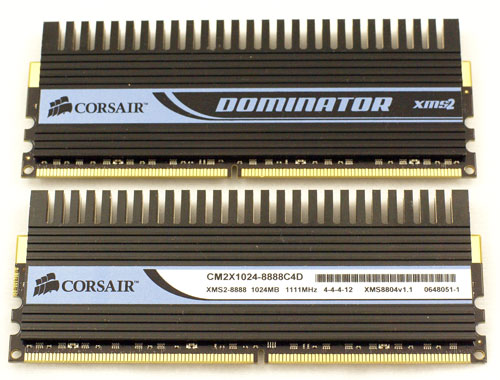
The PC2-8888 Dominator DIMMs are built with specially binned Micron D DDR2 memory chips. This is certainly not a surprise since OCZ Flex XLC and all the other recently tested top-of-the-line memory has used the same memory chips.
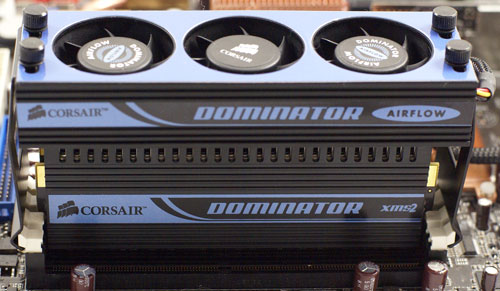
Once installed you have to agree the complete Dominator kit has a unique look. The Airflow fan kit, with quiet, down-facing fans, appears to do a good job of keeping the DIMM area cooler. This certainly contributes to better overclocking performance. We did not measure the temperature drop, as we're not sure how relevant the heatsink temp is to performance, but the finned composite heatsinks are noticeably cooler to the touch when overclocking with the Airflow fan kit attached.
| Corsair Dominator PC2-8888C4DF Memory Specifications | |
| Number of DIMMs & Banks | 2 DS |
| DIMM Size | 1GB |
| Total Memory | 2 GB |
| Rated Timings | 4-4-4-12 at DDR2-1111 |
| Rated Voltage | 2.4V |
Corsair Dominator fits the same DDR2 slots as past DDR2 memory, but the dual-path heat exchanger makes for a much taller DIMM. Add the Airflow fan on top and you have a tall memory area. However, while the volume is larger, a Dominator setup still has no problem fitting in a standard case. Since the Airflow fan occupies the same area as the memory module area, fan space requirements are actually less than a large fan resting on top of the DIMMs. We have no problem at all using a complete Dominator kit with the large Tuniq 120 air cooling system.
Memory Test Configuration
We have recently been testing memory with the ASUS P5W-DH Deluxe, which is based on the Intel 975X chipset. We did all initial testing on that platform, to provide results that can be conveniently compared to earlier test results.
The Intel platform was used because the first generation of AM2 on-processor memory controller does not support any memory timings below 3, or memory speeds above DDR2-800. Both these features are supported on the ASUS 975X motherboard. Timings of 2 are also available for RAS-to-CAS and RAS Precharge, and DDR2-1067 is an available memory ratio. In addition it was clearly illustrated in Conroe vs. AM2: Memory & Performance that DDR2 memory performance, in timings and required voltage, are equivalent on the AM2 and Core 2 Duo platforms.
However, with the evolution of the Intel P965 chipset and the NVIDIA 680i, it is clear that higher memory performance can be achieved with different memory "straps" used for the highest DDR2-1067 ratio setting. The P5W-DH Deluxe is very demanding of memory at high speeds and the "looser" base ratios used at the top of most P965 and 680i boards allow higher memory overclocks with some memory modules. Most memory performs about the same on 975X and P965, but we are aware of some DDR2 memory designs that perform best on the P965. Recently the NVIDIA 680i chipset has demonstrated an even greater range of performance at the top of memory overclocking, with extremely flexible options for squeezing the most performance from almost any memory.
For all of these reasons, we revised test procedures in recent DDR2 memory reviews. We first test standard memory performance and overclocking on the ASUS P5W-DH Deluxe. This allows valid comparisons to earlier reviews of DDR2 memory on the Core 2 Duo platform. We then run overclocking tests only on the NVIDIA 680i test platform, using the same X6800 Core 2 Duo processor. We will continue this test procedure until we can fully evaluate the NVIDIA 680i as a potential replacement for the Intel 975x as our memory test platform.
The memory test bench uses the following components:
| Memory Performance Test Configuration | |
| Processor: | Intel Core 2 Duo X6800 (x2, 2.93GHz, 4MB Unified Cache) |
| RAM: | 2x1GB Corsair Domintor PC2-8888C4D 2x1GB OCZ PC2-9200 Flex XLC (DDR2-1150) 2x1GB Patriot DDR2-1066 2x1GB Super Talent DDR2-1000 2x1GB Team DDR2-1000 2 x1GB Corsair CM2X1024-6400C3 2x1GB OCZ Ti Alpha PC2-8000 VX2 |
| Motherboards: | ASUS P5W-DH Deluxe (Intel 975X) EVGA NVIDIA nForce 680I SLI |
| Hard Drive: | Hitachi 250GB SATA2 enabled (16MB Buffer) |
| Video Card: | 1 x EVGA 7900GTX - All Standard Tests |
| Video Drivers: | NVIDIA 91.47 |
| CPU Cooling: | Tuniq Tower 120 |
| Power Supply: | OCZ PowerStream 520W |
| Operating System: | Windows XP Professional SP2 |
As for P965, we have seen cases where P965 boards performed much better than 975X units in memory speed, but where the P965 bandwidth was still the same or less than the 975X. On the very top memory, however, the P965 and 975X perform similarly. Since the ASUS P5W-DH Deluxe appears the more demanding platform we will continue testing base performance on the 975X.
However, a cross-section of enthusiast memory manufacturers were also asked which motherboard performed best with their top DDR2 memory. In all cases the answer that came back was the NVIDIA 680i motherboard. For that reason we have added the 680i to our tests of memory overclocking. Other alternatives will be evaluated for memory testing, but for now we will continue testing with the ASUS P5W-DH supplemented with the NVIDIA 680i tests for overclocking performance.
We recently reviewed value DDR2-800 from both G.Skill and Super Talent. Since those memories are really a different category than top-line DDR2, results for those two memories are not included in comparisons in this review. For comparisons of performance of those two memories you can refer back to the linked reviews.
Stock Memory Performance
Most of today's motherboards that support DDR2 provide a wide range of memory ratios that match available DDR2 memory. End-users can select the memory ratio that matches their DDR2 memory speed. Our memory testing uses the same approach. We first test all of the stock ratios at the fastest stable timings we can achieve at the given ratio. With ratios, CPU speed remains the same at 2.93GHz in our memory test bed, and memory speed is varied by selecting different ratios.
The memory controller for Intel Socket T (Socket 775) motherboards is in the chipset, instead of part of the processor as in AM2 systems. Therefore, there is the potential for some ratio variations in memory performance. There is theoretically a small performance penalty for speeds other than a 1:1 ratio (DDR2-533 in this case) on boards designed for Intel processors. However, the actual performance penalty has been found to be very small with minimal impact on test results. As a result memory scales well through the various speed options.
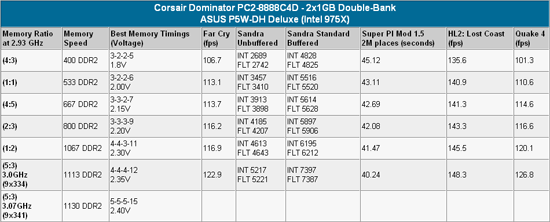 |
| Click to enlarge |
DDR2 memory is then pushed from the highest stock ratio that could be achieved in testing - normally 1067 - to the highest FSB speed at the stock multiplier. Unfortunately, the Corsair Dominator did not like the memory strap imposed by the ASUS P5W-DH board at DDR2-1067. The highest result we can reach at the 1067 strap was DDR2-1090. However, by lowering the base strap to DDR2-889 and increasing the clock speed we were able to reach specified timings on the ASUS 975X board at DDR2-1113 at 4-4-4-12 timings. Relaxing timings to 5-5-5 allowed a top speed of DDR2-1130 to be reached, but the bandwidth and performance was a bit lower than the more aggressive 4-4-4- timings so we did not complete testing at that speed.
It was time to see where this memory could go on the new NVIDIA nForce 680i chipset - a chipset that had exhibited some stellar overclocks in our initial chipset launch review and with a recent review of OCZ Flex XLC. Overclocking on the NVIDIA 680i was even more satisfying, as the Corsair Dominator set new speed records in several areas
 |
| Click to enlarge |
On the nForce 680i the OCZ Flex XLC took DDR2 memory performance to a new gold standard. On air cooling, Corsair Dominator reached DDR2-1315 which is the highest speed we have ever reached with any DDR2 memory. This was only slightly higher than the DDR2-1300 reached by OCZ Flex XLC, but anything faster than the best tested to now is an impressive achievement. Even more important was the fact that the Corsair Dominator reached DDR2-1233 using a linked memory speed configuration at the rated 4-4-4-12 timings. Performance of other DDR2 at DDR2-1100 4-4-4 has been impressive, but the Dominator reached 133MHz more to DDR2-1233. For overclockers looking for the highest speed at the fastest timings, the Corsair Dominator is a superb choice.
Memory Bandwidth Scaling
Memory bandwidth normally improves with increases in memory speed and reductions in memory timings. This is best illustrated using Performance Scaling charts.
Since the results for high-end memory were so close at all tested speeds, the scale range was reduced to better show the small differences in these memory benchmark results. Please keep this in mind when viewing the charts, since a normal zero scale would make performance differences appear much smaller than these expanded scale charts. Test values for each memory at each speed are included below each chart for reference.
To evaluate memory bandwidth SiSoft Sandra 2007 Professional was used to evaluate standard Buffered performance and Unbuffered memory bandwidth.
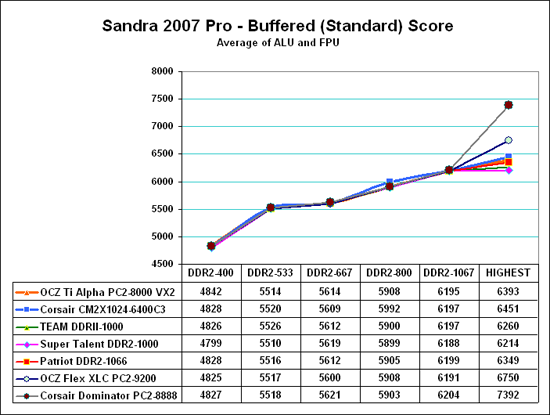
The most widely reported Sandra score is the Standard or Buffered memory score. This benchmark takes into account the buffering schemes like MMX, SSE, SSE2, SSE3, and other buffering tools that are used to improve memory performance. The Buffered benchmark does not correlate well with real performance differences in games, so our memory bandwidth tests have always included an Unbuffered Sandra memory score. The Unbuffered result turns off the buffering schemes, and we have found the differences in unbuffered results correlate well with real-world performance differences.
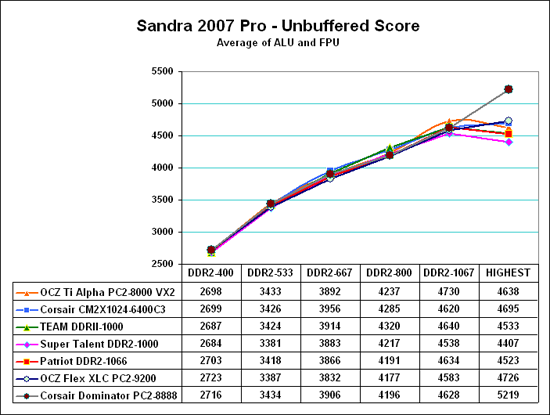
In both Buffered and Unbuffered tests Corsair Dominator performance curves mirror the best memory tested to DDR2-1066. While the differences are extremely small, Dominator more often than not is the fastest memory we have tested at any given speed. This is what would be expected since Dominator is based on the same core memory chips as the other tested memories. Memory bandwidth increases dramatically at the top in buffered bandwidth (standard test) on the 680i. This is mostly a result of the much higher overclock in memory that could be achieved with the Corsair compared to other Micron D-based memory. Unbuffered results also increase at the top speed, but not as dramatically as buffered results.
We also compared results with Version 1.5 of Super Pi - comparing the time to calculate two million places of Pi at the different memory speeds. This benchmark measures pure number crunching.
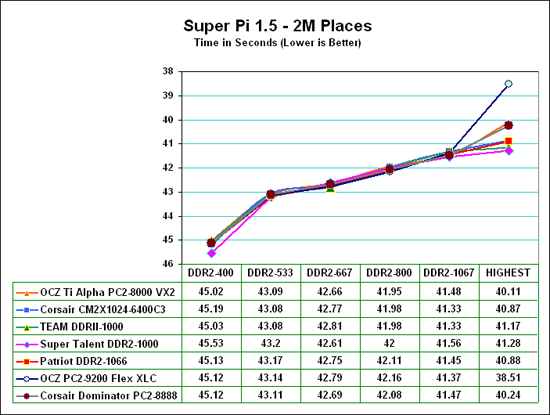
Super Pi results continue to improve to the highest speed that could be reached with stability with Corsair Dominator and other tested memories. What also stands out is how close the results with all the memories really are from DDR2-400 to DDR2-1066. This is mainly a reflection of the fact that compared memories are based on the same base Micron memory chips. At the highest speed Corsair Dominator and OCZ Flex XLC pull away from the pack with the record overclocks. The real difference between top overclock Super Pi results and stock DDR2-1067 results is very close. This shows the impact of CPU speed on calculation performance is much greater than the impact of memory speed increases.
Game Performance Comparison
Real-world benchmarks - specifically gaming benchmarks - provide the most useful measure of memory performance if you keep in mind what they represent. Memory is just one small part of overall gaming performance, and the AnandTech benchmarks keep everything the same except memory speed. Even the CPU speed is kept constant except in the overclocking tests. As a result performance improvements in FPS are very small because the only factor influencing the test results is memory speed. Many factors affect system performance, and memory speed is just one of those factors.
Results for high-end memory were very close at tested speeds. Therefore, the scale range was reduced to better show the small differences in these memory benchmark results at each speed. Please keep this in mind when viewing the charts. A normal zero scale would make performance differences appear much smaller than these expanded scale charts. Test values for each memory at each speed are included below each chart for reference.
The AT memory test suite uses Far Cry, Half Life 2 and Quake 4 for memory testing because they are sensitive to memory performance.
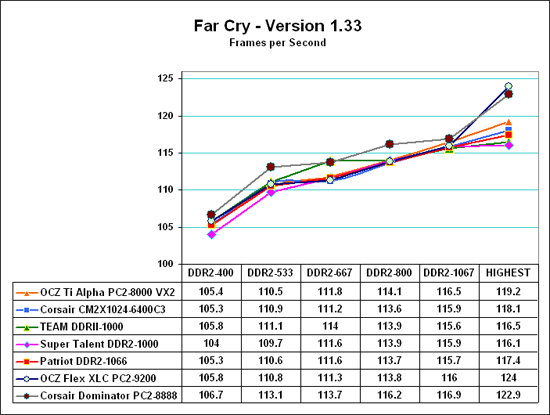
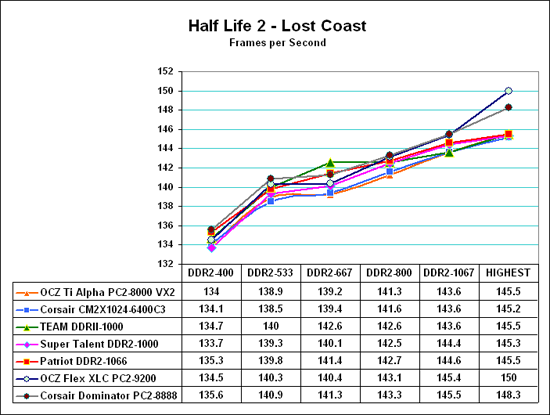
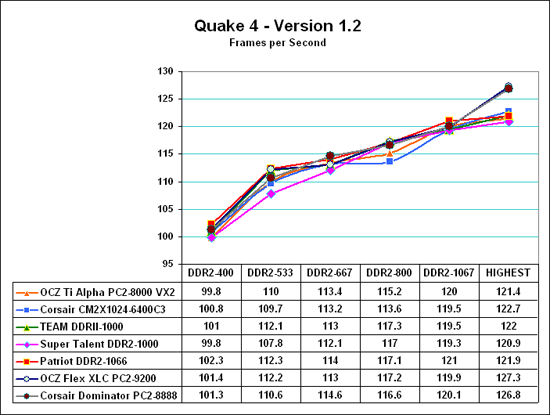
Despite the fact that memory is varying from 3-2-2-6 timings at DDR2-400 all the way to 5-5-5-18 timings at DDR2-1067 all three games continue to show improvement in frame rates as memory speed increases. Put another way, performance continues to improve as memory speed increases. This is the best evidence you will find to prove that increasing memory speed does increase performance - even to DDR2-1067 and beyond. Corsair Dominator again mirrored performance of the other Micron-based memory until we reached the top speed. More often than not it registered the highest test results, but the differences in performance at stock speeds are very small. Above DDR2-1067 Dominator broke away from the pack, producing the highest game test results we have seen so far at any overclocked speeds. This is no doubt the result of the tighter 4-4-4 timings that could be maintained all the way to DDR2-1233. Corsair Dominator set new performance records in every test category, and it managed to just edge the also fast OCZ Flex XLC in most gaming benchmarks.
Overclocking Performance (Highest Speed)
The Corsair Dominator PC2-8888 is rated at DDR2-1111 4-4-4-12, and we managed to reach that performance level on the ASUS P5W-DH Deluxe. As we've said before, the ratios on the ASUS 975X board are very demanding, and the earlier Dominator 1142 did not do nearly as well on this board. Top speed for the Corsair Dominator PC2-8888 was DDR2-1130, which is not much of an overclock going from 4-4-4 timings to 5-5-5 timings on the 975X. In fact OCZ Flex XLC managed to reach 1172 on this same board, but it is the only memory we have tested that performed better than the Dominator 1111 on this board.
With Dominator doing so well at 4-4-4 timings, it is probably best to only go to FSB speeds that Dominator can handle at 4-4-4 timings. Sticking to 4-4-4 timings will likely give you the best performance possible with this outstanding memory.
The Corsair Dominator on the NVIDIA 680i behaved like an entirely different memory, reaching much higher performance levels and overclocks than could be achieved on the P5W-DH. On the 680i the Dominator reached a stable DDR2-1315, which is the fastest performance we have ever measured on this board. Even more significantly, Dominator PC2-8888 was able to run all our benchmarks at 4-4-4 timings at DDR2-1233. This speed at 4-4-4 timings yielded top-notch performance in all our benchmarks. There are two components to memory performance - speed and memory timings - and the Corsair Dominator 1111 appears to excel in both areas.
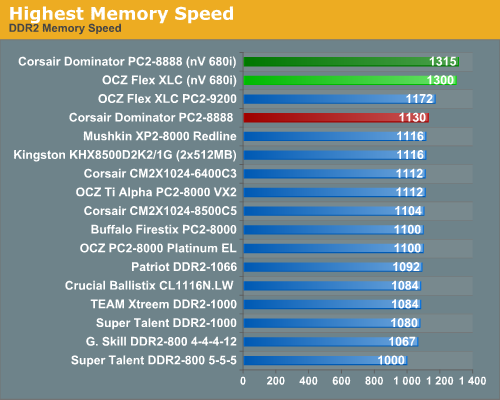
Only one other memory is in the same performance ball park with Dominator, and that is OCZ Flex XLC. Flex XLC comes close on the 680i, but Dominator wins in raw speed and best timings at a given speed. On the ASUS P5W-DH OCZ Flex seems to have the current compatibility edge. Dominator is fast on the 975x, but Flex edges it out for top performance on that platform. Given the 680i performance, however, we expect Corsair may well be able to push Dominator to the 975X lead as well - with something as basic as a BIOS or SPD upgrade.
Final Words
As was mentioned in the recent review of OCZ Flex XLC, the best DDR2 memory in the market is able to run at DDR2-800 3-3-3 timings and DDR2-1066 at 4-4-3. Those performance levels still have not changed. However Corsair Dominator PC2-8888 has added a new benchmark for enthusiast memory of DDR2-1233 at 4-4-4-12 timings. It was exciting to be running DDR2-1067 at 4-4-3 timings and reaching DDR2-1100 at 4-4-4 was something once thought impossible for DDR2. Now with Dominator running DDR2-1233 at 4-4-4 timings memory performance has pushed the envelope even further.
Now that memory is unified, with all major platforms running DDR2, the performance of DDR2 has moved forward with incredible speed. It doesn't appear Micron D can be pushed much further - even with aggressive binning - so we wonder what the next milestone will be and which memory chip or memory manufacturer will take us there.
For now if you are looking for the very best overclocking memory you can buy for your new rig, then Corsair Dominator PC2-8888 should definitely be on your list. So should OCZ PC2-9200 Flex XLC. Both memories provide remarkable performance and push DDR2 performance to new levels. The absolute fastest memory tested is definitely Corsair Dominator DDR2-1111, which reached DDR2-1315 at 5-5-5-15 timings and the even more remarkable DDR2-1233 at 4-4-4-12 timings. If your platform will be 680i or 650i then Dominator is your best choice. OCZ Flex XLC is a bit slower at DDR2-1300 on the same platform, but it is also an excellent choice.
If your new rig will use an Intel 965X chipset then Corsair Dominator is again a good choice. We reached over DDR2-1200 on an ASUS P5B in very limited testing. For a 975x motherboard we would tip the scales to the OCZ Flex XLC. Flex seems more at home on the demanding 975X platform and reaches higher overclocks, but Dominator is no slouch on the 975X either. The Corsair Dominator may be just an SPD upgrade away from being equally excellent on the ASUS P5W-DH Deluxe.
It's a lot of fun reviewing memory like the Corsair Dominator. It certainly isn't cookie cutter, and the performance levels reached truly make the testing worth the effort. Corsair has done a good job in analyzing the problems with pushing DDR2 speed, and their solution is both unique and effective. The 4-layer fins on Dominator cool very well, and when coupled with the three-fan and near silent airflow memory cooler, you can take DDR2 to new speed levels. The same can be said for the recently reviewed OCZ Flex XLC, which finds a different but equally effective solution to pushing memory speed to higher levels.
The question that remains is whether the speed gains also yield the performance increase that make the product worth what it costs. The unfortunate reality with Core 2 Duo and AMD is that neither platform is particularly bandwidth starved or bandwidth sensitive. This means the sometimes massive DDR2 speed increase we are seeing in innovative new designs like the Corsair Dominator often make only a small difference in bottom-line performance. Performance is better with the higher speeds as clearly demonstrated in out test results, but the real increases are very small.
The question then is whether memory that sells for $600 for a 2GB kit is worth it. You can certainly buy a 2GB kit for less than half that price that will provide most of the performance of the $600 kit. For those who measure their system purchases on a value basis it will be difficult to justify $600 for Corsair Dominator PC2-1111, even though it is the fastest memory we have tested. However, Corsair Dominator PC2-8888 was not designed for the value buyer. Many other companies, including Corsair, have memory products that will satisfy the value equation. Corsair Dominator PC2-8888 is for buyers who have to have the best - the fastest - the top performance - regardless of cost. If they buy PC2-8888 they will definitely get the best available on the memory market.
The Airflow fan unit is also available at Newegg and other vendors for about $20. If you have enthusiast memory or overclock, the Corsair Airflow fan is a great and useful accessory and a very good value for what it does. When you consider an 80mm fan jury-rigged into place will already cost $5-10, the $20 Airflow looks better, installs easier, and doesn't cost much at all - and it just might extend the life of your RAM if you run at higher voltages.







